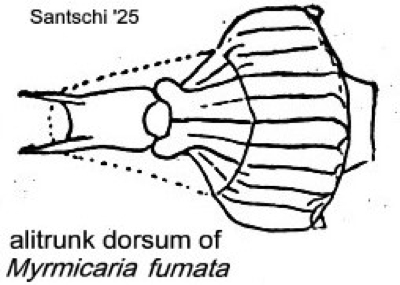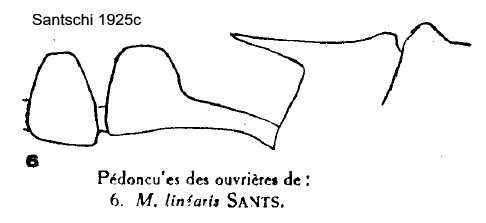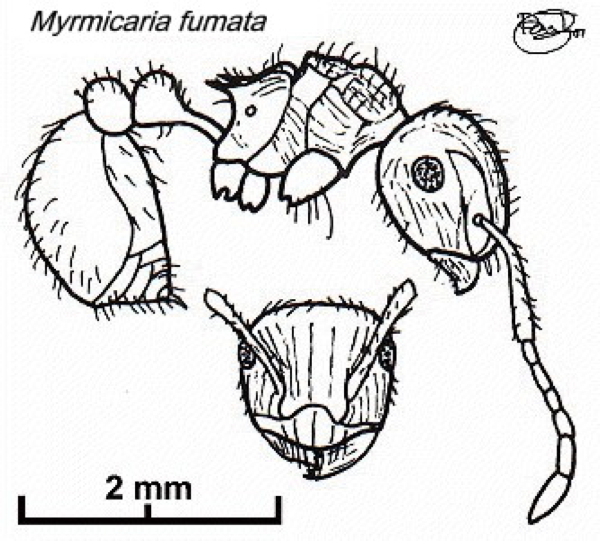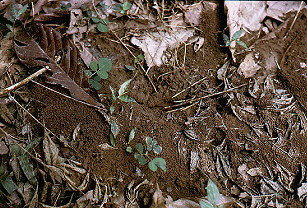Myrmicaria fumata Santschi
  Type location Ivory Coast
(Myrmicaria nitida Stitz var. brunnea, n. var.,
Santschi, 1915c: 254, worker; redefined as variety fumata
Santschi, 1916d: 242, raised to species by Santschi, 1925c: 160), from
near Dimbroko, by Posth, 1910 - see below Type location Ivory Coast
(Myrmicaria nitida Stitz var. brunnea, n. var.,
Santschi, 1915c: 254, worker; redefined as variety fumata
Santschi, 1916d: 242, raised to species by Santschi, 1925c: 160), from
near Dimbroko, by Posth, 1910 - see below
junior synonym (here) linearis (Santschi, 1925c:
161, illustrated, worker) from Zaïre, collected at Bokala by R.
Mayné - see http://www.antweb.org/specimenImages.do?code=casent0913041
worker only described (see Bolton, 1995)  . .
|
 Santschi's (1915c) description is at Santschi's (1915c) description is at  . .
|
Santschi (1925c) examining a single worker from
Dimbroko, Ivory Coast, apparently the specimen of his 1915
description, had the following description (most of the comparison
being with Myrmicaria
natalensis) -
TL 5.6 mm. Colour dark brown red; shiny. Sculpturation of head as in natalensis
but occipitum with more numerous (12-13) and more parallel rugae. The
median carina and the two adjacent rugae are closer together and more
distinct; transverse ridge on vertex more distinct and sinuous.
Alitrunk sculpture distinctive with the median carina extending back
across the two faces of the mesonotum; and the bordering rugae extend
forward onto the pronotum; being strong and parallel bifurcating
anteriorly towards the pronotal anterior border and anastomosing with
their neighbours. Inter-rugal spaces are smooth on each side of the
median ruga but a little striated around the promesonotal suture and
inequally rugose in the outer areas of the pronotum. The ridge
delimiting the faces of the mesonotum is somewhat advanced medially.
Sides of thorax with spaced striations, with large smooth spaces,
specially posteriorly. Both pedicel nodes with several rugae. Funiculus
striated. Remainder smooth together with the tarsi and base of the
gaster. Erect pilosity rust coloured, much shorter and sparser.
Head more rectangular, the eyes nearer the posterior border. Clypeus
smooth subcarinate. Funiculus segments shorter. Pronotum narrower and
less transversely convex, sides more clearly edged. Promesonotal suture
well defined. Lobes of mesonotum and propodeum similar in profile.
Petiole node as in striata but remainder as natalensis.
|
 His earlier description (1915c) of it as "M. nitida
var. brunnea) was - His earlier description (1915c) of it as "M. nitida
var. brunnea) was -
TL 5.6; brownish as gracilis Stitz. Shiny. Rugae on head
slightly stronger than on striata Stitz. Median ruga of
promesonotum well marked, bifurcated on anterior of pronotum as in nitida.
Propdeum dorsum very convex, smooth and shiny. Petiole nodes shiny with
feeble longitudinal rugae. Base of gaster feebly reticulate (punctate
in nitida). Head more obviously rectangular, posterior and
lateral borders straighter. Thorax relatively slimmer. Propodeal spines
slightly arcuate, and divergent, rectilinear and horizontal in profile.
Petiole slightly longer and higher. Single worker from near Dimbroko, Ivory
Coast, Posth, 1910.
Santschi (1933b: 105), reporting 6 workers collected
tending aphids on cotton at Ibadan, Nigeria, noted the rugae
were quite variable on the pronotum and occipitum; the median line on
the mesonotum does not always descend on the declivity but is
bifurcate; the head and middle of the gaster are brown; TL 5.2-5.6; the
second segment of the funiculus is a little longer than the third which
is as short as in foreli.
Bernard (1952) described this as a rare form known from
Congo and Guinea. Four workers were collected at N'Zo (a dry
forest area) by Lamotte. A further record was of a single queen taken
at Oubangui (location?) by A. Hollande, which extended its distribution
eastwards.
Santschi's (1925c) description of subspecies linearis
WORKER
TL 4.5-7.5 mm.
The main difference (from Santschi's key) are - colour a lighter red
brown, gaster often more. Pronotal rugae more numerous and less
well-defined. Propodeal dorsum raised and slightly concave anteriorly.
Also no well-defined ridge between dorsum and declivity of mesonotum.
|
 While
collating distribution records (March 2006), I realised the
identification I had from Bolton (1978, in litt.) of Nigerian
specimens as striata was almost certainly wrong and that what I
had studied, drawn and described was fumata. That is West
African as opposed to Myrmicaria
striata which is from southern Africa. While
collating distribution records (March 2006), I realised the
identification I had from Bolton (1978, in litt.) of Nigerian
specimens as striata was almost certainly wrong and that what I
had studied, drawn and described was fumata. That is West
African as opposed to Myrmicaria
striata which is from southern Africa.
Nigeria specimen (as Myrmicaria striata
in Taylor, 1980a: 9). WORKER. TL 5.57 mm, HL 1.24, HW 1.24, SL 1.03, PW
0.90
Colour dark brown, shiny. Head and alitrunk, especially the dorsum, are
longitudinally rugose. Mesonotum with a lamellate lateral margin.
Propodeal spines moderately long, acute and flat to down-turned.
Petiole and postpetiole with rounded nodes.
|
 The photomontage of the
type worker is collated from http://www.antweb.org/specimen.do?name=casent0915405. The photomontage of the
type worker is collated from http://www.antweb.org/specimen.do?name=casent0915405.
|
In Nigeria it was ground nesting, preferring
bare, insolated soil (pictured left). Will construct sunken runways in
soil surface. At the Cocoa Research Institute of Nigeria, Idi Ayunre,
it was fairly common, on 0.1-1.0% of cocoa trees, tending aphids and
stictococcids on cocoa flowers and pods, and constructing tents of
"mortared" soil (pictured right). Some of the tents were associated
with cocoa black pod infections, it was frequently on the trees
together with Camponotus acvapimensis, see E5/1 study (Taylor & Griffin,
1981). In other cocoa areas of western Nigeria it appeared to be much
less common. Earlier from CRIN, perhaps on > 0.25% of cocoa in pkd
collections from two cocoa blocks, W13/2 and W18/1 (Booker 1968), and
Eguagie (1971) found it at Ilugun near Ibadan.  
Lévieux (1983a) mentions it (as striata) as one
of the two genus members populating the savannah in Ivory Coast,
where its nests were hardly noticeable from the surface, being hidden
under ground. He commented that little else was known of its biology.
|
Oxford University Museum
specimens
Myrmicaria fumata
B Taylor det. |
Senegal
Tambacounda
B Ndiaye
|
12.v.2009
Bransan
13°16'0" N
12°6'0" W
|
Bransan 12-V-09 St 9
P10B
Soudanian savannah, pitfall traps
|
3
|
 |
Myrmicaria fumata
B Taylor det.
|
Benin
J-F Vayssieres
RVA 3094.1
|
10.xi.2011
Tanquiéta
10°40'05'' N
01°18'14'' E
|
Acacia dudgeoni
beating
234 m asl
|
2
|
 |
|
 The
photomontage is of workers from Senegal,
Bransan; collector B Ndiaye The
photomontage is of workers from Senegal,
Bransan; collector B Ndiaye
|
 The
photomontage is of a major worker from Benin,
Tanquiéta; collector J-F
Vayssieres (RVA 3094). The
photomontage is of a major worker from Benin,
Tanquiéta; collector J-F
Vayssieres (RVA 3094).
|
 The
photomontage is of a minor worker from Benin,
Tanquiéta; collector J-F
Vayssieres (RVA 3094). Matches the type worker (shown above). The
photomontage is of a minor worker from Benin,
Tanquiéta; collector J-F
Vayssieres (RVA 3094). Matches the type worker (shown above).
|
|